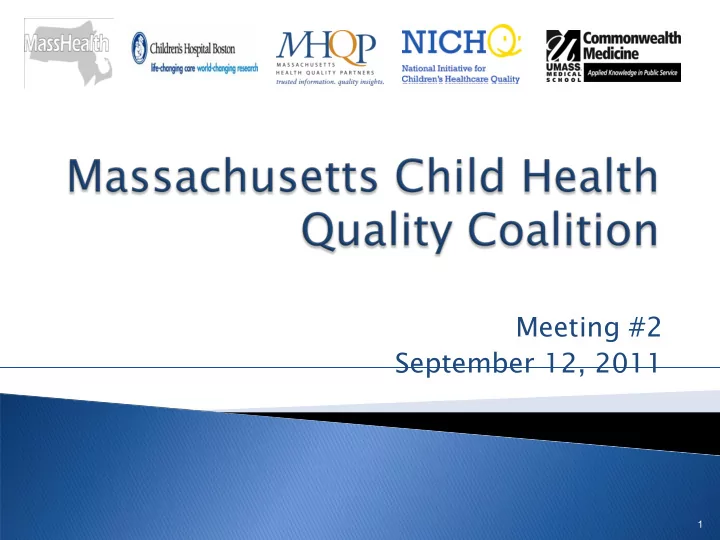

Meeting #2 September 12, 2011 1
Review priority gap areas identified by Gap Analysis and Prioritization (GAP) Workgroup Discuss short-term and long-term roles and pathways for Coalition in gap areas Discuss process and next steps to determine initial set of target areas for Coalition focus Provide background on the AHRQ/CMS Pediatric Quality Measures Program (PQMP) and discuss strategies for working with the Coalition 2
Coalition Charter Coalition evaluation process Proposal for at-large Coalition members Workgroups 2012 meeting dates 3
Workg Workgrou roup Mem p Members bers Joan Pernice, MA League of CHC Andrew Balder, BMC Health Plan Joyce Pulcini, MA Coalition of Jeanne Clapper, Parent and Nurse Practitioners Home First, HMEA Janice Singer, MHQP Mark Doherty, DentaQuest Patrick Tigue, Community Institute Catalyst Beth Dworetzky, MA Family Kathleen Walsh, UMass Voices @ Federation for Memorial Hospital Children with Special Needs Barry Zallen, BCBSMA Elena Eisman, MA Psych. Assoc. Brent Martin, Commonwealth Medicine/MassHealth Sta taff Melinda Karp, MHQP Louise Bannister, CHIPRA Grant Lauren Piccolo, MHQP Project Director Gina Rogers, MHQP Christy Bonstelle, Children ’ s Hospital Boston 4
GAP workgroup ◦ Two in-person meetings with additional offline work Data/evidence collection ◦ Wide-ranging data sources, research evidence Stakeholder input ◦ Coalition member pre-meeting survey input ◦ 14 interviews completed (MA child health practitioners ’ insights on care coordination, prevention, disparities, etc) Family input ◦ 207 responses received ◦ Additional insights from orgs with direct parent support Core Selection Principles Working List of Priority Gaps 5
Summary tables and data sources provided in handouts ◦ Commonwealth Fund/Kaiser/Casey Kids Count state report cards, CDC, NS-CSHCN, MA MCH Needs Assessment, MA YRBS, MYHS, MA DPH Essential School Program reports, MHQP Clinical Quality Performance and Patient Experience Surveys, BCBSMA prevalence and cost ranks (pediatric members) IMPORTANT: priority gaps often identified where there are not good measures, makes quantifying gaps difficult 6
Survey developed by GAP Workgroup and MA Family Voices; asked parents to talk about the biggest challenges they face in promoting their child's health. Westwood/Mansfield MA Family Voices Pediatrics 86 responses, SE MA 121 responses statewide 30% of children identified as 55% of children identified as CSHCNs CSHCNs Average age: 9.4 Average age 11.1 Most respondents receive Insurance: health insurance through o 30% MassHealth, employer o 65% through employer, o 5% purchase insurance privately 7
Whole child care concept, focusing on integration of behavioral, oral, and physical health Infrastructure for addressing both cost and quality; lack of alignment of how payers and providers are measuring value; measurement across systems Partnerships between families, health care professionals, and communities/ schools Addressing disparities 8
Care Coordination Care Transitions Prevention/Health Promotion Access/Availability Quality Measurement/Improvement Patient/Family Partnerships Disparities Refer to to th the 21 gap areas in th the document t Working List t of Priority ty Gap Areas 9
10
Active engagement ◦ Developing consensus statements, white papers, guidelines, measures, clearinghouse venue for best practices Facilitating collaboration ◦ Supporting alignment of measurement and systems improvement programming among stakeholders, supporting multi-stakeholder grant proposals, dissemination/integration of about active engagement activities Endorsement/raising awareness ◦ Public education campaigns/materials, highlighting gap areas/reporting on improvement 11
The Coalition does not t have an operational role in forwarding systems transformations The Coalition does does have a policy level role in forwarding system transformations The Coalition roles/pathways on the previous slide are not mutually exclusive but could (and likely will) represent different points of Coalition activity within a given gap area 12
Pr Proposed sed Logic gic Model: el: IF the Coalition does XXXX, THEN YYYY changes will occur to improve the delivery, outcomes, or costs of child health care in MA IF the Coalition does XXXX, THEN YYYY child health outcomes will be improved Proposed Crite teria: Identified gap area from gap analysis Urgent or timely need; long vs. short term Low-hanging fruit/quick win Level of resource intensity required Opportunity to leverage ongoing work 13
14
Take today ’ s Coalition input back to Strategy Workgroup (aka GAP Workgroup) for further discussion Strategy Workgroup to develop recommendations for initial coalition focus areas, roles, and pathways for discussion and approval at January Coalition meeting 15
16
Next Meeting January 2012 17
Recommend
More recommend